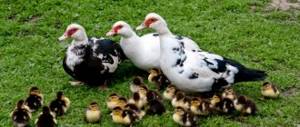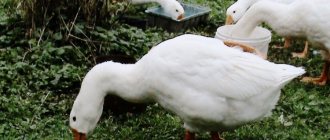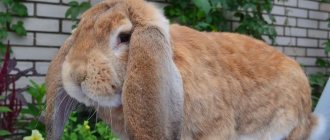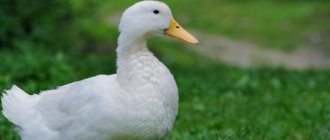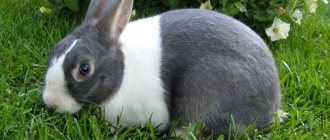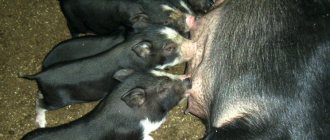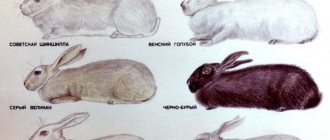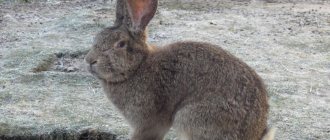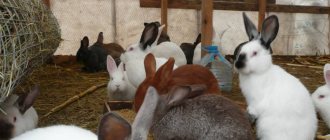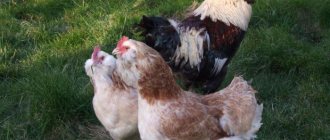Description of the breed
Photo:
Rabbits of the Fold Sheep breed are loyal and affectionate pets who will become true friends for household members if you treat them with love and care, never leave them alone and keep their home clean.
External features
Fluffy, cute rabbits do not have any common characteristics with lambs, but the name “loop-eared sheep” was received by the animals due to their short, massive head and wide forehead. The animals have a strong back of the head, serious large eyes and plump cheeks. These characteristics make the rabbit look like a cute little charmer.
Fold-eared sheep rabbits have very long ears hanging along their heads, which are their main attraction.
In adults, the length of the ears can reach 25 centimeters. The shell is turned inward, the shape of the ears resembles horseshoes. The drooping ears are slightly rounded at the tips, and their bases are thickened.
The physique of the decorative breed of fold sheep is very interesting: the body shape is cylindrical, the chest is wide, and the neck is short. The back of the body is rounded, the tail is small.
Weight
Fold rams are often shown at international and local exhibitions. By the time of their maturity, lop-eared dwarf pets weigh no more than 1-2 kilograms.
If the weight of dwarf animals is above 2 kilograms, they are not allowed to exhibit. There are anatomical differences between biologically identical males and females: females are larger than males and lack a dewlap.
Character
Fold-eared rams are responsive to the affection of people, and if treated with a friendly attitude, they are distinguished by peaceful habits and a very friendly character.
It’s not worth offending big-eared kids, thinking that they can’t stand up for themselves. Rabbits can bite an offender very painfully. It’s quite difficult for such a big-eared family pet to get along with a cat.
Rabbits are very careful animals, so adaptation to a new owner occurs gradually. Attempts to forcibly remove the little ear from the cage will only frighten him.
Huddled in the farthest corner, the animal will warily watch the human hands. It is better to open the cage door slightly, calmly waiting until the baby rabbit’s natural curiosity overcomes the feeling of fear and he wants to stick his nose into the open doorway.
You need to approach the cage with calm steps, without sudden or sweeping movements of your arms. You can interest your pet in a tasty treat by talking to him in a friendly, quiet voice.
A rabbit that is showing excessive aggressiveness should be gently pressed to the floor with your hand. The rabbit, in order to defeat its opponent, jumps on the animal's back. With such a movement, a person demonstrates that the force is on his side, forcing the pet to yield leadership rights to the owner.
In his free time, the decorative ram rabbit loves to dig trenches and holes, jump on heights, make his way through long tunnel passages to the goal, chase small bouncing and rolling objects, and tear everything that yields with his teeth.
In the absence of suitable toys, an angry pet can tear upholstery on chairs, tear off wallpaper that has slightly peeled off the wall, or tear a newspaper thrown in a hurry to shreds.
To entertain your rabbit, you can purchase or build small houses, tunnels, houses, and baskets yourself. You can move some of the toys into the eared cat’s cage. You can distract the attention of a pet that has had enough of playing with a tasty treat and slowly send it back to its cage. Things valuable to people should not be on the playing area.
Popular types of fold sheep
There are about twenty species of lop-eared rabbits in total. Attempts to develop new breeds do not stop at the present time.
Before deciding to purchase a pet, you should familiarize yourself with the descriptions and characteristics of existing breeds. They differ in the shape of their head, body, long hair and ears. There are both large individuals weighing more than 4 kg and miniature animals that weigh less than 1.5 kg.
List of six popular breeds of lop-eared rabbits:
- American longhair sheep.
- French ram.
- Dutch lop-eared rabbit.
- English fold ram.
- German ram.
- Lion-headed lop-eared rabbit.
Rabbit German ram
Origin story
The characteristic external features of lop-eared rabbits attract many breeders. Slightly enlarged head cartilages and ears turned inward by the pinna give them some resemblance to rams. Fold-eared sheep were mentioned in his works by Charles Darwin, who more than once encountered unique species of plants and animals in his travels.
In the 18th century, when crossing rabbits of the dwarf breed and French lop-eared rabbits, dwarf lop-eared ram rabbits were born. In 1950, Dutch breeders developed the first dwarf breeds. The world learned about a new interesting breed of rabbits 2 years later, after which the rapid conquest of lop-eared lambs in European countries began.
Only in 1997 did this breed become known in Russia. The first nurseries of this breed were just beginning to appear in large Russian cities. In Europe and the USA during these years, fold-eared rams were already bred with all their might.
Breeders encountered some difficulties at the beginning of their experiments. The ears of a small dwarf ram do not differ in massiveness and length. For this reason, these individuals had them standing upright rather than hanging.
Painstaking work and thorough research helped achieve the desired result. As soon as the age of the dwarf rabbit approaches 12 weeks, the ears that stubbornly stick out to the sides and upwards begin to lie along the head.
Sometimes this can happen in one ear first, and then in the other a few days later. During this period, pets look a little comical, resembling naughty pranksters in appearance.
History of breeding
The “Dwarf Ram” rabbit breed appeared as a result of the selection of two varieties: dwarf individuals and French fold rabbits. This breed quickly gained popularity all over the world: the small size of the animals with “mutton” faces amazed with their charm and beauty.
Such rabbits first became known at the end of the 18th century. In Russia, this breed became popular on the eve of the 2000s, thanks to the creation of several nurseries with animals imported from Europe.
Breed varieties, color
In terms of external and qualitative characteristics, the varieties of the lop-eared sheep breed are very different:
- Meissen is a rare breed found in Germany;
- French - has become widespread in all countries;
- English - the owner of tiny front paws and large ears;
- plush - a rabbit with short, thick and soft hair;
- fleecy - distinguished by long hair;
- Dwarf and Dutch are the smallest breeds that live primarily in domestic conditions.
Valuable “coat”, high quality meat and attractive appearance are characteristic of all these breeds. The coat of animals is characterized by a wide variety. Plain white, black, gray, brown coat tones are often diluted with spots of a different color or tan marks.
Caring for a lop-eared rabbit
The French rabbit is bred in an apartment as a favorite pet or on farms for meat and fur products, so keeping can be indoors or in cages. Despite the slight differences between the two species, the requirements for keeping a fold-eared sheep remain the same:
- there is a drinking bowl and feeder in the cage, which the animal cannot spoil or overturn;
- the house is protected from sunlight, strong wind and moisture;
- the cage must be regularly cleaned and kept clean;
- In the place where the rabbit is placed there should be no sharp corners or edges of objects that could injure the pet’s delicate ears.
If the fold-eared sheep was brought in as a pet and lives in the same house with family members, then the animal must be vaccinated. The velvety coat also requires care - the pet is regularly combed and washed when it gets dirty. At home, lambs are kept in free cages and released only in the presence of their owners. The pet's house should be kept clean and tidy, so the cages are equipped with a tray.
It should be remembered that rabbits are nocturnal animals, and the peak of animal activity occurs in the evening and night, and in the morning the lambs are apathetic and inert. With good care and compliance with maintenance rules, the lifespan of French decorative rabbits is 7 years.
When breeding fold sheep on a farm, they must be kept in spacious, warm cages, since the breed does not tolerate cold. Due to its peaceful and quiet nature, group keeping is possible - 3-4 individuals in an enclosure. The floor of the cages is lined with hay so that the animals do not freeze; fresh twigs are placed inside so that the pets do not start gnawing on their home.
Price
You cannot buy a “rabbit in a poke”. Before purchasing, the animal must be carefully examined:
- A healthy pet should have a cold and wet nose;
- the eye sclera should be shiny and clean;
- Frequent scratching and matted fur may indicate fleas;
- An animal that constantly licks the anus and tries to sit on the floor with its backside may be infected with worms;
- Diseases of the internal organs may be indicated by cloudy eyes, protruding bones, and an empty, sagging abdomen;
- Bald spots on the body indicate infection with lichen.
The price of a lop-eared ram rabbit varies depending on the pedigree, beauty and rarity of the breed. An ornamental animal without a pedigree costs from 1 to 2 thousand rubles. A pet-class lop-eared cat costs on average from 1 to 2.5 thousand rubles.
If the owners intend to breed a certain breed, it is necessary to purchase a breed-class rabbit-ram, for which they will have to pay from 2 to 4 thousand rubles.
Handsome men with pedigree displayed at exhibitions (show class) are valued at 3-5 thousand rubles. Prices for beautiful and very rare breeds, for example, Dutch Folds, can reach up to 8 thousand rubles.
The purchase should be made during the period when wool does not grow. This will allow you to carefully examine the coat for bald spots.
How to choose a pet
Rabbits of the dwarf fold ram breed are born with straight ears and acquire a characteristic appearance only by 2-3 months. Therefore, it is advisable to buy them no earlier than this age and only from trusted breeders.
When choosing a decorative lop-eared rabbit, it is recommended to pay attention to:
- for the presence of a pedigree and veterinary passport;
- health status;
- compliance with the breed standard;
- conditions of detention;
- behavioral features.
A healthy baby rabbit has smooth, shiny fur, a moist, cool nose and clear eyes. He is moderately well-fed, active and interested in the world around him. A baby rabbit with scratchy skin, matted, patchy fur, cloudy eyes, protruding bones, or a sagging belly has serious health problems. It is better to refrain from such a purchase.
The decorative lop-eared rabbit is a cute miniature animal with a friendly and playful disposition. With proper care and proper feeding, he will live a long life and become an excellent companion for the owner's children.
Owner reviews
The dwarf sheep is widespread throughout the world. It is perfect for keeping in a family. Children over 10 years old can communicate with the animal independently. When getting a rabbit for a small child, you need to control it so that it does not cause injury to this animal.
Most owners note the proud disposition of fluffies. Despite their modest size, they are very active and require a lot of attention.
The undoubted advantages of keeping a dwarf lop-eared sheep rabbit include:
- the animal is harmless, cute and fluffy;
- does not require constant washing;
- Rabbit food is inexpensive;
- is easy to train to the tray;
- With good care, it lives for about 10 years.
The most common disadvantages of keeping rabbits at home are:
- frequent mood swings;
- shedding every few months;
- in some cases may cause allergies in children;
- require constant attention of the owner;
- may have a slight odor.
Diet of rabbit lop-eared ram
We recommend reading our other articles
- Onion varieties per feather
- Planting grape seedlings in spring
- Apricot variety Alyosha
- Tomato variety Malinovka
The lop-eared rabbit ram feeds in the same way as other ornamental species.
- Stern. They are purchased in pet stores in large or small packs. There is simple food, and some with treats (dried fruits, nuts, vegetables).
- Greens are always given dried, not fresh. After collection, it should lie down for about 2-3 days and only then can it be given to the pet.
Rabbit diet
- Vegetables and fruits are desirable especially in winter, when there is no greenery. In this case, you can feed carrots, apples, pumpkin, turnips, zucchini, parsnips, and beets. Give cabbage, tomatoes, bananas, strawberries, citrus fruits with caution - only in small quantities.
- Hay is an integral part of the diet of the decorative lop-eared sheep rabbit. It is given every day if the cage is empty. It is especially important in winter as an alternative to greenery.
That, in general, is the whole diet. It is important to provide food several times a day and ensure that the rabbit does not go hungry. It is advisable to use a nipple drinker for water so that it does not quickly become dirty.
Breeding
Breeding dwarf fold rabbits is not difficult. Starting from 6 months of age, rabbits can reproduce safely. Fold rams are not particularly fertile. The female carries the rabbits for 28-36 days. With proper care, female rabbits can produce 6-7 rabbits in one litter.
A pregnant rabbit needs to be provided with maximum care. You need to keep the cage clean and give the animal more protein-rich, nutritious food.
Fresh, clean water is important for the female; it is recommended to give low-fat homemade cottage cheese and a hard-boiled egg once a day. In order for a mother rabbit to feed her babies for a long time, you need to disturb the animal as little as possible.
Sterilization and castration
At the onset of puberty, the ram rabbit begins to mark its territory and becomes restless and restless. Games with children are no longer interesting for the eared boy.
For females, the solution to the problem is sterilization, and for males, castration. After the operation, the ram becomes peaceful and calm. He is sleeping well, is interested in play again, and has a healthy appetite.
Starting from 4 months of age, females can be sterilized, but, according to many veterinarians, it is better to postpone the operation until 6 months of age, when the animal’s body becomes stronger and more mature and recovers faster after surgery.
The best age for castration of a male is 3.5-5 months. Experts do not give a definite answer as to whether it is possible to operate on individuals who have reached the age of 1-3 years. Most are inclined to believe that the operation is much more difficult for pets in this case. Before carrying out it, you must pass all the necessary tests and check the condition of the internal organs.
Reviews from breeders about the dwarf lop-eared ram rabbit
Photo of Rabbit Lop-eared ram
What is the opinion of breeders about the lop-eared ram rabbit?
- Natalia Beloshchuk : “For 3 years now, we have been living with a lop-eared ram rabbit, a German breed. A very touching miracle! But I wouldn’t recommend it for families with children. It scratches very hard with its hind legs, and can even bite.”
- Oleg Bondarenko : “Honestly, I never thought that a rabbit needs so much care. It may be small, but it requires a lot of care. Although you don’t need to walk him like a dog, you need to walk him at home, as well as pet him, play with him, comb him, wash him, trim his nails, and so on. So such a “toy” will not let you get bored - I assure you.”
- Elena Zimina : “The lop-eared rabbit ram became a friend of our family in 2013. We took his sick man off his hands and went home. He apparently realized that they loved him here and began to cause mischief in every possible way. There’s no reaction to “you can’t”, but you don’t want to scold him either - he’s a bundle of happiness!”
Feeding
The rabbit's diet should be nutritious, complete and varied:
- Among vegetables, the ram prefers potatoes, broccoli, carrots; you should not feed him potato tops, tomatoes, beets, white cabbage and cauliflower;
- slightly dried and fresh meadow grass, dandelion, nettle will be a good source of vitamins in the summer;
- oats and wheat are suitable for grain crops;
- In winter, a fold-eared ram will like an armful of dry, fragrant herbs.
For rabbits, the main food is hay and nutritious grain mixtures. Before 6 months of age, you should not treat your baby to raw vegetables and fresh herbs, because the delicate digestive tract is not yet ready to absorb fiber and coarse fibers.
A grown rabbit can be given vegetables, fruits and green grass daily in small quantities. There should always be hay in the cage - a source of vital substances for the rabbit.
Oats, wheat, and crackers can be given as solid food, but in very moderate quantities. Rabbits should not be given dairy or meat products. Pets can sometimes be given milk for up to 2.5 months. There should always be standing, clean water in the cage. A mineral stone sold in pet stores should be attached to the wall of the cage.
Care and maintenance
By nature, fold-eared dwarf baby rams are rodents, so it is not at all surprising that they constantly need to chew something.
Rabbits will mercilessly tear apart wires that are not removed to a safe distance in the house. Eared pets can receive an electric shock at any time.
The permanent “place of residence” of a dwarf lop-eared ram will be a cozy, spacious cage that meets the following requirements:
- Dimensions no less than 0.7x0.5 meters.
- It is advisable to arrange a “house” in the cage - a safe shelter for your pet, in which he will feel completely protected.
- The location of the cage should be selected very carefully. It should be ventilated, but without cold drafts, well lit.
- Dwarf rams are quite clean by nature, so they will choose a corner for the toilet, in which you need to place a tray. Designed for cats is quite suitable for this purpose. You can use a special triangular corner tray.
- To prevent your pet from throwing cups in different directions and clinging to them with his paws, it is better to attach a drinking bowl with water to the wall of the cage, and use heavy ceramic dishes for the feeder. Moreover, no matter how much he wants, the baby will not be able to chew on it.
- It is advisable to let the rabbit out of the cage at least once a day for several hours so that it can stretch its legs.
- Use a special nail clipper to remove sharp claws so that the furniture in the house is not scratched.
The cleanliness of the feeders must be constantly monitored and the availability of clean water must be constantly taken care of. Animals eat frequently; the work of their gastrointestinal tract is based on pushing food through the arrival of new portions.
Pets can eat and defecate at the same time. For convenience, a feeder with hay is placed next to the tray. Well-dried wood shavings or finely shredded newsprint without printing ink are the best bedding materials.
Folds take care of the condition of their fur themselves, so they are bathed very rarely. The main thing is not to forget to clean their cage regularly and provide the animal with a clean tray every day. A ram demanding cleanliness will not go into a dirty litter box.
Content
The first thing you need to do before getting a rabbit is to remove all the wires. Otherwise, the rabbit may get an electric shock as it will chew on everything.
First you need to get a cage.
It doesn’t matter whether it’s bought in a store or made with your own hands, it must meet several requirements :
- the cage must be large enough, at least 0.7 * 0.5 m ;
- Rabbits live in holes, so there must be a house . This is especially important at first, when the animal gets used to the place and people;
- An excellent option is cells, where part of the space is divided into 2 floors.
The cage should be placed in a certain place - low-traffic, sufficiently light and protected from drafts.
Dwarf rams , as a rule, go to the toilet in one place, which is very convenient - you can simply put a tray in this corner.
You can use a regular cat litter box , or a special corner one. It is designed for rodents living in cages, has a triangular shape and is attached to the bars of the cage.
To avoid a mess in the cage , use ceramic heavy feeders - the rabbit’s teeth will simply slide along them, and hang the drinkers on the walls.
In addition, rabbits must be allowed to run for at least a couple of hours a day.
If you don’t want to let him into the room , you can make a special enclosure with a bottom - then it will be easier to clean, and you won’t need to remove the wires.
About nutrition
Proper nutrition for a rabbit is of great importance.
Babies under six months should not be given raw fruits and vegetables, or fresh herbs. When the rabbit grows up, all this can be given in small quantities.
The main food of a rabbit is hay and grain mixtures. Both can be bought in the store.
Hay is the basis of the diet and should always be present in sufficient quantity.
You also need to purchase a mineral stone and attach it to the bars of the cage.
Taming
- A rabbit is a proud and independent creature, so you shouldn’t take it out of its cage , it should feel safe there.
- It is better to open the cage and wait until the pet becomes interested and comes out.
- You need to approach the cage slowly so as not to scare the dwarf ram.
- And, of course, a tasty treat .
- Sometimes a rabbit can behave aggressively . There may be several reasons for this behavior - from fear to banal sexual arousal.
- When trying to bite , you need to show who dominates this house - very carefully press the rabbit to the floor. The fact is that in nature, rabbits demonstrate their superiority by jumping on the back of their opponent.
- You definitely need to trim your rabbit's claws . There are special nail clippers for this. You need to cut carefully so as not to touch the vessel.
- If the rabbit begins to behave unusually , refuses treats, or the fur becomes dull, this may indicate an illness.
- At the first symptoms, you need to measure the rabbit's temperature ( normal - 38.3-39.5 ).
- If your temperature is only slightly elevated, it may be a sign of stress.
- If it exceeds 40 , it indicates the need to contact a veterinarian.
- However, before doing this, you need to bring down the temperature a little by using ice packs briefly applied to the ears and belly of the lop-eared sheep.
In general, communicating with a rabbit is reminiscent of communicating with a child: you don’t need to hang over it, it’s better to squat down; You should speak calmly, without showing emotions.
After daily close communication, you may dream about a rabbit. Find out what dream books write about rabbits.
